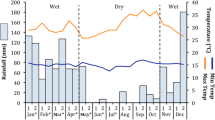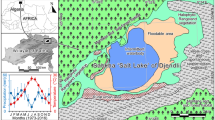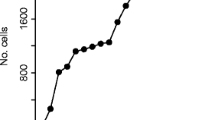Abstract
Annual cycles in day length are an important consideration in any analysis of seasonal behaviour patterns, since they determine the period within which obligate diurnal or nocturnal animals must conduct all of their essential activities. As a consequence, seasonal variation in day length may represent an ecological constraint on behaviour, since short winter days restrict the length of the time available for foraging in diurnal species (with long summer days, and thus short nights, a potential constraint for nocturnal species). This paper examines monthly variation in activity patterns over a 4-year study of chacma baboons (Papio cynocephalus ursinus) at De Hoop Nature Reserve, South Africa. Time spent feeding, moving, grooming and resting are all significant positive functions of day length, even before chance events such as disease epidemics and climatically mediated home range shifts have been accounted for. These results provide strong support for the idea that day length acts as an ecological constraint by limiting the number of daylight hours and thus restricting the active period at certain times of year. Day length variation also has important implications across populations. Interpopulation variation in resting time, and non-foraging activity in general, is a positive function of latitude, with long summer days at temperate latitudes apparently producing an excess of time that cannot profitably be devoted to additional foraging or social activity. However, it is the short winter days that are probably of greatest importance, since diurnal animals must still fulfil their foraging requirements despite the restricted number of daylight hours and elevated thermoregulatory requirements at this time of year. Ultimately this serves to restrict the maximum ecologically tolerable group sizes of baboon populations with increasing distance from the equator. Seasonal variation in day length is thus an important ecological constraint on animal behaviour that has important implications both within and between populations, and future studies at non-equatorial latitudes must clearly be mindful of its importance.


Similar content being viewed by others
References
Agetsuma N, Nakagawa N (1998) Effects of habitat differences on feeding behaviours of Japanese monkeys: Comparison between Yakushima and Kinkazan. Primates 39:275–289
Altmann J (1974) Observational study of behaviour: sampling methods. Behaviour 49:227–267
Altmann J (1980) Baboon mothers and infants. Harvard University Press, Cambridge, Mass.
Andrews JR, Birkinshaw CR (1998) A comparison between the daytime and night-time diet, activity and feeding height of the black lemur, Eulemur macaco (Primates : Lemuridae), in Lokobe Forest, Madagascar. Folia Primatol 69:175–182
Aujard F, Vasseur F (2001) Effect of ambient temperature on the body temperature rhythm of male gray mouse lemurs (Microcebus murinus). Int J Primatol 22:43–56
Baldellou M, Adan A (1997) Time, gender, and seasonality in vervet activity: a chronobiological approach. Primates 38:31–43
Barrett L, Henzi SP (1998) Epidemic deaths in a chacma baboon population. S Afr J Sci 94:441–441
Barrett L, Gaynor D, Henzi SP (2002) A dynamic interaction between aggression and grooming reciprocity among female chacma baboons. Anim Behav 63:1047–1053
Barton RA (1989) Foraging strategies, diet and competition in olive baboons. PhD thesis, University of St. Andrews, Fife, UK
Barton RA, Whiten A, Strum SC, Byrne RW, Simpson AJ (1992) Habitat use and resource availability in baboons. Anim Behav 43:831–844
Blackburn TM, Gaston KJ (1996) Spatial patterns in the body sizes of bird species in the New World. Oikos 77:436–446
Bronikowski AM, Altmann J (1996) Foraging in a variable environment: Weather patterns and the behavioral ecology of baboons. Behav Ecol Sociobiol 39:11–25
Caraco T (1979a) Time budgeting and group size: a theory. Ecology 60:611–617
Caraco T (1979b) Time budgeting and group size: a test of theory. Ecology 60:618–627
Cardillo M (2002) The life-history basis of latitudinal diversity gradients: how do species traits vary from the poles to the equator? J Anim Ecol 71:79–87
Clutton-Brock TH (1977) Some aspects of intraspecific variation in feeding and ranging behaviour in primates. In: Clutton-Brock TH (ed) Primate ecology. Academic Press, New York, pp 557–579
Clutton-Brock TH, Harvey, PH (1977) Primate ecology and social organisation. J Zool 183:1–39
Cox GW, Hunt J (1992) Relation of seasonal activity patterns of valley pocket gophers to temperature, rainfall and food availability. J Mamm 73:123–134
Cowlishaw G (1998) The role of vigilance in the survival and reproductive strategies of desert baboons. Behaviour 135:431–452
Crook JH (1970) The socio-ecology of primates. In: Crook JH (ed) Social behaviour in birds and mammals. Academic Press, London, pp 103–166
Crook JH, Gartlan JS (1966) Evolution of primate societies. Nature 210:1200–1203
Curtis DJ, Rasmussen, MA (2002) Cathemerality in lemurs. Evol Anthropol Suppl 1:83–86
Curtis DJ, Zaramody A, Martin RD (1999) Cathemerality in the mongoose lemur, Eulemur mongoz. Am J Primatol 47:279–298
Dasilva GL (1992) The western black-and-white colobus as a low-energy strategist: activity budgets, energy expenditure and energy intake. J Anim Ecol 61:79–91
Davidge C (1978) Activity patterns of chacma baboons (Papio ursinus) at Cape Point. Zool Afr 13:143–155
Deshmukh IK (1984) A common relationship between precipitation and grassland peak biomass for East and southern Africa. Afr J Ecol 22:181–186
Dixon P (2001) The development of ecological and social competence in juvenile baboons. PhD thesis, University of Liverpool, UK
Dunbar RIM (1988) Primate social systems. Chapman and Hall, London
Dunbar RIM (1992a) Time: A hidden constraint on the behavioural ecology of baboons. Behav Ecol Sociobiol 31:35–49
Dunbar RIM (1992b) A model of the gelada socio-ecological system. Primates 33:69–83
Dunbar RIM, Sharman M (1984) Is social grooming altruistic? Z Tierpsychol 64:163–173
Fa JE (1986) Use of time and resources by provisioned troops of monkeys: social behaviour, time and energy in the Barbary macaque (Macaca sylvanus L.) at Gibraltar. Contributions to Primatology, vol 23. Karger, Basel, Switzerland
Gaynor D (1994) Foraging and feeding behaviour of chacma baboons in a woodland habitat. PhD thesis, University of Natal, South Africa
Hall KRL (1962) Numerical data, maintenance activities and locomotion of the wild chacma baboon, Papio ursinus. Proc Zool Soc Lond 139:181–220
Hamilton WJ III (1982) Baboon sleeping site preferences and relationships to primate grouping patterns. Am J Primatol 3:41–53
Henzi SP, Lycett JE, Weingrill T, Byrne R, Whiten A (1997) The effect of troop size on travel and foraging in mountain baboons. S Afr J Sci 93:333–335
Henzi SP, Barrett L, Weingrill A, Dixon P, Hill RA (2000) Ruths amid the alien corn: males and the translocation of female chacma baboons. S Afr J Sci 96:61–62
Hill RA (1999) Ecological and demographic determinants of time budgets in baboons: Implications for cross-populational models of baboon sociobiology. PhD thesis, University of Liverpool, UK
Hill RA (2003) Daylength seasonality and the thermal environment. In: Brockman DK, van Schaik CP (eds) Primate seasonality: implications for human evolution. Cambridge University Press, Cambridge (in press)
Hill RA, Dunbar RIM (2002) Climatic determinants of diet and foraging behaviour in baboons. Evol Ecol 16:579–593
Houérou HN le (1984) Rain use efficiency: a unifying concept in arid land ecology. J Arid Environment 7:213–247
Jarman PJ (1974) The social organisation of antelope in relation to their ecology. Behaviour 48:215–267
Lawes MJ, Piper SE (1992) Activity patterns in free-ranging samango monkeys (Cercopithecus mitis erythrarchus Peters, 1852) at the southern range limit. Folia Primatol 59:186–202
Linnane MI, Brereton AJ, Giller PS (2001) Seasonal changes in circadian grazing patterns of Kerry cows (Bos taurus) in semi-feral conditions in Killarney National Park, Co. Kerry, Ireland. Appl Anim Behav Sci 71:277–292
Malpaux B, Viguie C, Skinner DC, Thiery JC, Pelletier J, Chemineau P (1996) Seasonal breeding in sheep: mechanism of action of melatonin. Anim Reprod Sci 42:109–117
Matsumoto-Oda A (2002) Behavioral seasonality in Mahale chimpanzees. Primates 43:103–117
McFarland DJ (1974) Time-sharing as a behavioural phenomenon. Adv Stud Behav 5:201–225
Ménard N, Vallet D (1997) Behavioral responses of Barbary macaques (Macaca sylvanus) to variations in environmental conditions in Algeria. Am J Primatol 43:285–304
Mercer JG, Adam CL, Morgan PJ (2000) Towards an understanding of physiological body mass regulation: seasonal animal models. Nutr Neurosci 3:307–320
O'Brien GM, Curlews JD, Martin L (1993) Effect of photoperiod on the annual cycle of testis growth in a tropical mammal, the little red flying fox, Pteropus scapulatus. J Reprod Fert 98:121–127
Owen-Smith N (1994) Foraging responses of kudus to seasonal changes in food resources: elasticity in constraints. Ecology 75:1050–1062
Owen-Smith N (1998) How high ambient temperature affects the daily activity and foraging time of a subtropical ungulate, the greater kudu (Tragelaphus strepsiceros). J Zool 246:183–192
Owens IPF, Bennett PM, Harvey PH (1999) Species richness among birds: body size, life history, sexual selection or ecology? Proc R Soc Lond B 266:933–939
Perret M, Aujard F, Vannier G (1998) Influence of daylength on metabolic rate and daily water loss in the male prosimian primate Microcebus murinus. Comp Biochem Physiol A 119:981–989
Post DG (1981) Activity patterns of yellow baboons (Papio cynocephalus) in the Amboseli National Park, Kenya. Anim Behav 29:357–374
Post DG (1982) Feeding behaviour of yellow baboons (Papio cynocephalus) in the Amboseli National Park, Kenya. Int J Primatol 3:403–430
Raemakers (1980) Causes of variation between months in the distances travelled daily by gibbons. Folia Primatol 34:46–60
Roberts SC, Dunbar RIM (1991) Climatic influences on the behavioural ecology of Chanler's mountain reedbuck in Kenya. Afr J Ecol 29:316–329
Rodrigues FHG, Monteiro-Filho ELA (2000) Home range and activity patterns of pampas deer in Emas National Park, Brazil. J Mammal 81:1136–1142
Sharman M (1981) Feeding, ranging and social organisation of the guinea baboon. PhD thesis, Yale University, Conn.
Slatkin M, Hausfater G (1976) A note on the activity patterns of a solitary male. Primates 17:311–322
Stacey PB (1986) Group size and foraging efficiency in yellow baboons. Behav Ecol Sociobiol 18:175–187
Stelzner JK (1988) Thermal effects on movement patterns of yellow baboons. Primates 29:91–105
Struhsaker TT, Leland L (1979) Socioecology of five sympatric monkey species in Kibale Forest, Uganda. Adv Stud Behav 9:159–228
Tattersall I (1987) Cathemeral activity patterns in primates: a definition. Folia Primatol 49:200–202
Williams JB, Anderson MD, Richardson PRK (1997) Seasonal differences in field metabolism, water requirements, and foraging behaviour of free-living ardwolves. Ecology 78:2588–2602
Williamson DK (1997) Primate socioecology: Development of a conceptual model for the early hominids. PhD thesis, University College, London
Acknowledgments
We thank Cape Nature Conservation for permission to work at De Hoop Nature Reserve and Giel Hugo and Overberg Toetsbaan for access to long term climatic records. We are grateful to two anonymous reviewers for helpful comments on an earlier version of the manuscript.
Author information
Authors and Affiliations
Corresponding author
Additional information
Communicated by D. Watts
Rights and permissions
About this article
Cite this article
Hill, R.A., Barrett, L., Gaynor, D. et al. Day length, latitude and behavioural (in)flexibility in baboons (Papio cynocephalus ursinus). Behav Ecol Sociobiol 53, 278–286 (2003). https://doi.org/10.1007/s00265-003-0590-7
Received:
Revised:
Accepted:
Published:
Issue Date:
DOI: https://doi.org/10.1007/s00265-003-0590-7




